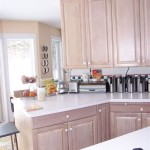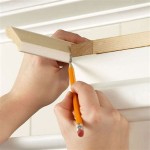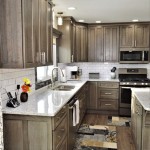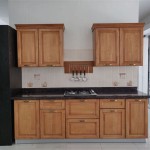DIY Paint Wood Kitchen Cabinets: A Comprehensive Guide
Painting wood kitchen cabinets is a cost-effective and transformative project that can revitalize the look of your kitchen without the expense of a full remodel. With careful preparation and the right techniques, you can achieve a professional-looking finish that will last for years to come.
Preparation:
1. Remove Cabinet Doors and Hardware: Take off all cabinet doors and remove all hardware, such as hinges, knobs, and handles. Label each door and its corresponding hardware to avoid confusion later.
2. Clean and Degrease: Thoroughly clean the cabinets with a degreasing cleaner to remove any dirt, grease, or oil that may prevent the paint from adhering properly. Use a clean cloth and warm water to wipe down the surfaces.
3. Sanding: Lightly sand the cabinets with fine-grit sandpaper (220 grit or higher) to remove any imperfections or glossy finishes. This will help the paint adhere better.
Painting:
1. Prime: Apply a coat of primer specifically designed for kitchen cabinets. Primer helps seal the wood, prevents stains from bleeding through, and improves the adhesion of the paint.
2. Paint: Choose a paint that is specifically formulated for kitchen cabinets. Water-based latex paints are easy to clean and resistant to stains. Apply a thin, even coat and allow it to dry completely.
3. Second Coat: Apply a second coat of paint in the same manner as the first. Allow it to dry completely before reinstalling the doors.
Reassembly:
1. Reattach Hardware: Reattach the cabinet doors and install the hinges, knobs, and handles. Ensure that all hardware is securely fastened.
2. Touch-Ups: Once the cabinets are reassembled, inspect them for any imperfections or missed spots. Touch up as needed to achieve a flawless finish.
Tips for a Professional Finish:
1. Use High-Quality Materials: Invest in a good primer and paint designed for kitchen cabinets. Cheap materials can lead to peeling, chipping, or yellowing over time.
2. Allow Adequate Drying Time: Follow the manufacturer's instructions for drying time between coats. Rushing the process can result in poor adhesion or uneven coverage.
3. Use a Paintbrush or Roller: For a smoother finish, use a high-quality paintbrush or roller. Spray painting can create a more textured finish.
4. Protect the Floors: Cover the floors with drop cloths or plastic sheeting to prevent paint splatter.
5. Ventilate the Area: Painting releases fumes, so ensure adequate ventilation by opening windows or using a fan.

How To Paint Kitchen Cabinets In 7 Simple Steps

Diy Painting Your Kitchen Cabinets The Right Way

Diy Painted Oak Kitchen Cabinets Makeover

A Diy Project Painting Kitchen Cabinets

How To Paint Kitchen Cabinets A Step By Guide Confessions Of Serial Do It Yourselfer

20 Diy Painted Kichen Cabinet Ideas A Cultivated Nest

Avoid These Mistakes How To Paint Cabinets That Are Already Painted Grace In My Space

How To Simply Update Your Cabinets With Paint In A Day This Is Our Bliss

Pa Wedding Photographer Diy Painted Kitchen Cabinets Before After

Tips For Painting Kitchen Cabinets Stacy Risenmay
Related Posts








